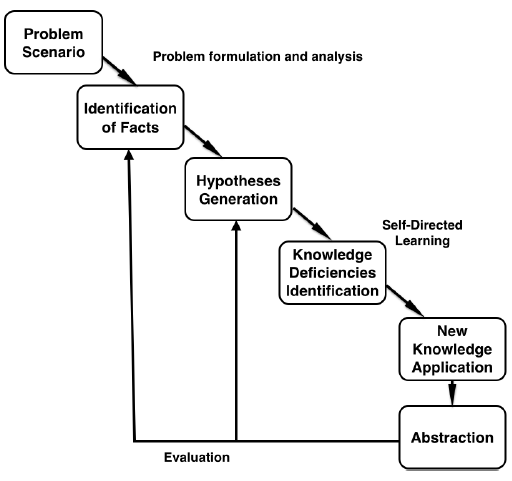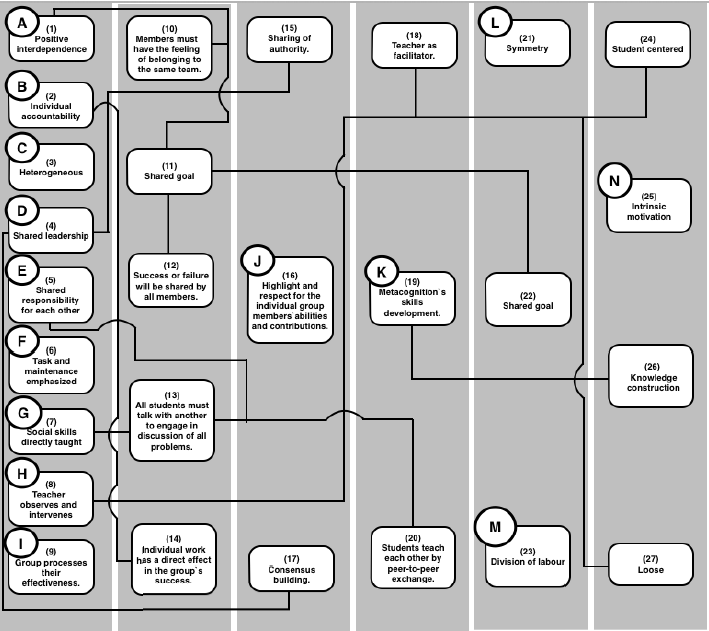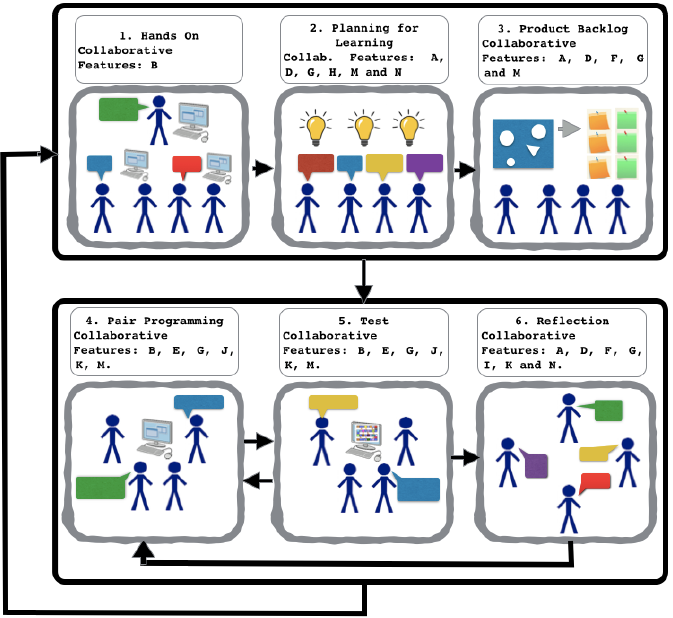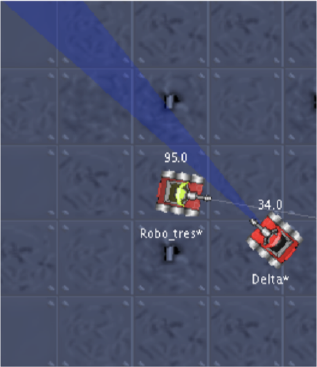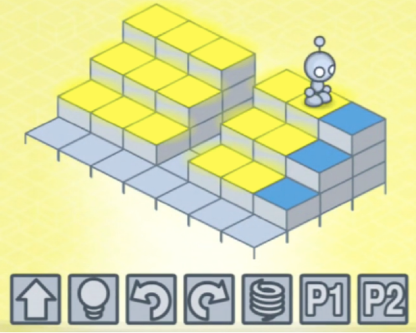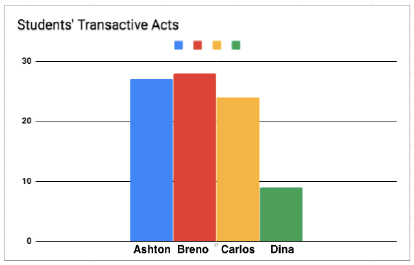1. Introduction
The development of students’ CT skills can bring great advances to education. Through Computational Thinking, students can exercise logical reasoning, solve complex problems, deal with abstraction among other capacities. According to [1], CT can be understood as a problem solving methodology that can be automated, transferred and applied across all subjects. Students do not become just tool users, but also builders.
Collaboration is also a key aspect of learning as we are social beings. Collaborative Learning helps students acquire social skills and build knowledge [2]. In this sense, Collaborative Learning is a situation in which particular ways of interaction among people are expected to occur, which would trigger learning mechanisms, but there is no guarantee that the expected interactions will actually occur. Hence, a general concern is to develop strategies to increase the probability that some types of interaction occur [2]. In addition to it, Digital Games can be important allies in CT learning once learners can propose solutions that could be experienced in an animated environment with graphics and colors. This is, therefore, a generally fun process for students [3]. The author of [4] reports that one of the most frequently reasons mentioned by researchers in the use of such strategies is the attractiveness that games provide for the new generation students.
This paper aims to describe a framework for teaching Computational Thinking skills through digital games using collaborative learning features. Due to the essence of Computational Thinking, the approach takes into account the stages of Problem-Based Learning strategy to solve the challenges aimed by the game environments. The proposed approach can be applied both in the use of digital games -which involve algorithms learning- and in the game building itself. A evaluation of the framework was carried out via its application in high school and undergraduate classes. Quantitative and qualitative data analysis were performed. Results obtained showed that the approach is promising. This article is an extension of the research proposed by [5].
2. Theoretical background
2.1 Computational thinking
As described earlier, Computational Thinking is a problem-solving approach that can be implemented on a computer. Therefore, it is about thinking like a Computer Scientist [6]. CT can be used to support problem solving across all disciplines, including the humanities, math, and science [1, 7]. Therefore, CT can develop a set of mental skills for students to empower their capabilities on the reasoning process [1]. According to [7, 8], the core CT skills are:
Decomposition: Breaking down data, processes, or problems into smaller, manageable parts.
Pattern Recognition: Observing patterns, trends, and regularities in data.
Abstraction: Identifying the general principles that generate these patterns.
Algorithm Design: Developing the step by step instructions for solving this and similar problems.
The proposed framework focuses mainly on the Algorithm Design and Decomposition skills.
2.2 Collaborative/cooperative learning
Some authors make a distinction between cooperative and collaborative learning, others treat concepts as if they were the same [9]. In this study, we will fit into the second group. The authors of [10] state that cooperation is not having students sit side-by-side at the same table talking with each other and doing their individual assignments. As the authors explain, cooperation is much more than being keeping students physically close, helping other students, or sharing materials with each other - although these are important acts of cooperation. The author of [10] explain that Cooperative Learning must involve four basic elements:
Positive interdependence;
Face-to-face interaction among students;
Individual accountability; and
Students appropriately use interpersonal and small-group skills.
We will talk more about the features of cooperative/collaborative learning strategies in Section 4.
2.3 Games and learning
Digital Game-Based Learning may be closely related to problem-solving. According to [11], Digital Game Based-Learning is a process of awakening to an active pedagogy in which the student builds his own knowledge. In this sense, digital games support challenges, cooperation, engagement and the development of problem-solving strategies [12]. According to the author, games can help students learn to collaborate, solve problems, collect and analyze data, test hypotheses, and engage in discussions.
In the problem scenario context, games involve situations that are as important as the process of solving them [11]. The player passes through situations in which the decisive steps are to identify the problem inherent and search for a solution that improves his situation. In this sense, this problematization process supports the development of skills such as creativity, leadership and improvisation. Also, the problematic scenarios of digital games can assist in hypotheses conception. This happens because the games propose problems in an arranged way so that the initial ones are well constructed to lead the players to formulate hypotheses that work well to solve harder problems that will appear later [13]. Besides, games allow players to solve challenging problems until they have virtually routinized or automated their solutions. Thus, the game throws a new class of problems to players, requiring them to rethink their acquired knowledge. Users need to learn something new and must integrate this new understanding into their previous knowledge [13].
As explained, the collaborative aspect of games is also taken into account by different authors. According to [14], using game elements can increase people’s engagement in collaborative activities. As reported by [13], some games can explore multifunctional teamwork. In this kind of game, players work in a team in which each member has different skills. Such a player must master his skills and understand the specialties of others to cooperate with the team.
Despite the advantages presented, many challenges can be faced by teachers when they are trying to adopt digital games in the classroom. In the research performed by [15], the author reports that the inflexibility of curriculum, students’ lack of readiness, lack of supporting materials, negative effects of gaming, fixed class schedules, and limited budgets are elements that limit teachers in this aspect. Another challenge is placed in the difference between using digital games for play and using them in a formal context. For this reason, methodologies must be developed to adopt digital games in the classroom [12]. This makes the proposal of methods and frameworks for game-based learning (as presented in this article) relevant to support the application of games in the classroom.
2.4 Problem based learning
The authors of [16] explains that in Problem Based Learning (PBL) approaches, students work in small collaborative groups and learn what they need to know in order to solve a problem. PBL is well suited to helping students become active learners because it situates learning in real-world problems and makes them responsible for their learning. The collaboration happens through the negotiation of ideas and when individual students bring new knowledge to the group for employment on the problem-solving process. Collaborative problem-solving groups are a key feature of PBL.
Problem-solving often requires social interaction and consequently the development of interpersonal skills. The group work promoted by the PBL improves collaboration, as students should explain concepts and ideas and compare, confront and discuss divergent points of view. These actions create a collaborative environment in which students develop values that include the ability to listen and observe what another says; the solidarity built up among all; the search for truth in the relationships and the way of acting of each and every member; and the potential of correcting each other and waiting for the common learning rhythm, considering the time of each one [17].
Many studies claim that knowledge building is directly related to the problem-solving process, students learn when they are solving problems. The constructivist nature of PBL is highlighted by [18] because of its student-centered approaches. In this sense, PBL goes beyond simple concepts memorization, as it is done through expositive lectures [17]. The PBL promotes the understanding of the subject which also facilitates the memorization and, consequently, the learning. The author of [16] mapped a series of studies that show some indications that PBL can build extensive and flexible knowledge in addition to improving effective problem-solving skills.
The problem has a very important role in PBL. Therefore, the proposal of a significant problem must be carefully studied and planned by the teacher. The authors of [17], based on some studies, list a series of fundamental aspects that a good problems’ scenario must keep, which are.
Students’ interested attraction - the theme should stimulate research to expand the concepts, be authentic and provide a connection between the subject’s schedule content and the students’ daily lives.
Correspondence between curriculum content and learning - students should note that there is consistency between the background and the objectives defined in the course plan.
Depth - the scenery must be easily learned through visual, audible or textual content. Also, it must hold sufficient content to attract the attention and curiosity of the student, it must be challenging and bring enough knowledge to formulate hypotheses and arguments to solve the problem.
Ideal size - the scenery should not be too long or too small. The problem should also not be too complex, which obstructs the understanding of the concepts, or too simple in a way that makes it impossible to reflect and discuss the content to be studied.
A PBL life cycle is presented by [16] as can be seen in Figure 1. As explained before, the proposed framework implicitly contemplates this PBL cycle.
3. Related work
CT learning through games in collaborative activities has received attention from researchers. The authors of [19] explore the impact of the switching period on Pair Programming (PP) approach. They conducted a PP experiment in four classes in the sixth grade in a primary school and used Alice, an environment to build Games and Animations. An agile software engineering framework that relies on a set of principles and practices that can be mapped to the activities of CT is presented by [20]. The framework focuses on building games and animations through the design of mind maps and storyboards, and Scratch programming. They conducted an experiment in two sixth-grade classes. The authors of [21] describe an experience of African-American middle school girls who engaged in collaborative game design to learn CT for social change. They use Scratch and AppInventor to build the games. Our approach differs from the others by considering several aspects of Collaborative Learning. In addition, our approach focuses on problem-solving strategies.
4. Methodology
First, in subsection 4.1, a mapping of the main collaborative learning characteristics (that were called features) defined by different sources will be presented. This mapping was used as a basis for the development of the proposed framework. The overview and steps of the proposed framework will be described in subsection 4.2.
4.1 Mapping collaborative learning
Based on a literature review about Collaborative Learning features, we propose a diagram [Figure 2] that illustrates connections between such features presented by different sources - [2, 9, 10, 22]. Each of them could be identified by a number, and was vertically grouped by sources. Each column represents a set of features from the same source. In this sense, the connections represent similarities. Two connected items in the diagram represent two features given by two different sources, but with the same meaning. It is important to observe that the connection was made only between the concepts that we considered explicitly related according to our view. So each cluster (set of connected features) is represented by a letter. This grouping is important to reduce the complexity of the collaborative framework we proposed. A reader could verify that there are other implicit connections between concepts. Some items are related, but not directly, for example, in order to share leadership, it is necessary that individuals respect and highlight individual group members‘abilities and contributions.
4.2 Proposed framework
The approach makes the use of Digital Games aimed to learn algorithms and programming to solve challenges, such as Light-Bot and Robocode. The framework can also be applied directly to Digital Game production. The proposed approach was designed to fit all collaborative features from Figure 2. Figure 3 shows a diagram with the steps that should be adopted. The top of each step shows the correspondent collaborative feature from Figure 2 letter that fits that stage. As can be seen in Figure 3, all collaborative items from Figure 2 were contemplated, except for features C and L. Characteristic C concerns the group being heterogeneous and characteristic L concerns the group being symmetrical. As these are features that depend on the group‘s composition, these items must be observed in a pre-performing step where the students are forming the teams.
Therefore, according to Figure 3, the strategy consists of the following steps:
Hands-On: Teacher will present the Game Environment, or the Digital Game, and the possibilities, opportunities and challenges on playing or building the game. This will be done by a Hands-On where learners will make a walk-through. Students need to pay attention to contribute to the group later. This is the least collaborative step of the strategy. Collaborative Feature B - Individual accountability - is the only one present in this step.
Planning for Learning: Students should plan their own learning. Therefore, they should discuss the questions: What are the previous expectations? What previous knowledge do they have to solve the problems that may arise? What knowledge do they want to achieve? Which product/solution is expected? At this stage, learners can also outline a general strategy for solving the problems. The role of the teacher is to stimulate the discussion by questioning the students and letting the them discuss freely. The teacher can also intervene to keep expectations and goals viable. The Collaborative Features involved are: A - Positive interdependence; D - Shared leadership, G - Social skills directly taught; H - Teacher observes and intervenes; M - Division of labor - work together; and N - Intrinsic motivation.
Backlog: From a general delimited strategy, learners will define more specific steps to be taken. The idea is to divide the product/problem to be solved into smaller series problems. The teacher‘s role is the same as step 2. The main Collaborative Features involved are: A- Positive interdependence; D- Shared leadership; F-Task and maintenance emphasized; G- Social skills directly taught; an dM-Division oflabor work together.
Pair Programming: Learners perform pair programming. Teacher intervene only if asked by them in case of doubts or to ensure that the keyboard (for programming) is being shared. It is recommendedtouseatimertosetthestudents’turns for keyboard use. The main Collaborative Features involved are: B - Individual accountability; E- Shared responsibility for each other; G- Social skills directly taught; J- Highlight and respect for the individual group members’ abilities and contributions. K- Metacognition‘s skills development; and M- Division of labor.
Tests: Students will perform tests running the proposed solution. They are expected to have fun with the result, even if a conclusive solution is not found. Teacherinterveneonlyifaskedbythestudents. The main Collaborative Features are the same as the previous step.
Reflection: Learners and teacher attend a meeting to reflect on the session. Some questions that can be addressed at this meeting: What has been done? What did we learn? What do we need to improve? What are the next steps? The teacher will participate as a moderator. The main Collaborative Features involved are: A- Positive interdependence; D- Shared leadership; F-Task and maintenance emphasized; GSocial skills directly taught; I- Group processes their effectiveness; K- Metacognition‘s skills development; and N- Intrinsic motivation.
Evaluation
The framework was evaluated in two stages. First, we used an interaction análisis approach that involved a single group. At this stage, the Robocode game was adopted. After that, we applied a survey to two whole classes. At this stage, the LightBot game was applied. These evaluation stages as well the applied games will be described in the following section.
5.1 Interaction analysis
The approach was performed in a group with four high school earners (three male and one female). The students volunteered to participate in the project. The session lasted about 1h30min. For the activities development, the game Robocode was chosen - Figure 4. Robocode is a programming game, where the goal is to develop a robot battle tank to battle against other tanks in Java or .NET. The robot battles are running in real-time and on-screen [23]. This game was chosen because it allows students to define strategies and implement them according to the multiple programming procedures available. Also, the fact that battles take place in real-time can make the activity more dynamic and keep students motivated to win.
In order to verify if there was collaboration in the problem solving process and if this collaboration was related to the success or failure in the accomplishment of the task, we will perform the method of analysis adopted by [24]. The method applied by the authors allows us to identify and classify interactions involving transactive discussions among the learners (acts of collaboration) and their results in the successor failure of problem solving. Bythis approach, [24] observed on their research that success (in problem solving activities) is characterized not only by utterances which are simultaneously metacognitive and transactive, but also by interactions involving purely transactive discussion. This analysis was performed on the steps 2, 3, and 4 of the framework because these are the steps that directly require problem-solving acts from students.
The data collecting is done by recording the sessions. The analysis’ focus is on the students‘conversational turns - which [24] called Moves. A coding scheme is applied to Moves in order to identify metacognitive acts. These acts could represent new information that was recognized or an assessment of particular aspects of the solution. Therefore, we use two classes of metacognitive acts: New Idea, which potentially useful information came to light or an alternative approach was suggested; and Assessment of the execution or appropriateness of a strategy, the accuracy or sense of a result, or of one’s knowledge or understanding. A second kind of codification is also performed. Some Moves are identified as Transacts, which are clarifications, elaborations, justifications, and critiques of one’s own or one’s partner’s reasoning.
There are three types of transacts: statements, questions and passive responses. The operations are labeled on one’s partner’s ideas as other-oriented and there asoning directed atoner’s own ideas as self-oriented. In order to facilitate the conversation analysis and their impact on the success or failure in the solution, a graph connecting metacognitive acts and transacts (as proposed by [24]) were built from the recorded interactions.
5.2 Survey
The second stage of the assessment consisted of employing a survey and a post-test. The survey aimed to collect quantitative and qualitative data from learners. The idea was understanding student’s awareness of learning, collaboration and fun. The post-test was performed to verify if the students learned the algorithms concepts that were proposed in the activity. The approach was performed in a third-year high school class (31 students 23 female and 8 male) and a Bachelor of Education class (41 students - 36 female and 5 male).
For this stage, we chose the game LightBot - Figure 5. The game LightBot allows players to move a robot to solve various challenges by designing algorithms. The programming is done visually by blocks that represent robot actions, such as moving forward, turning, jumping, among others. The game goal is to make the robot automatically follow a defined path to light up small boxes. According to [25], LightBot has been played by over 20 million kids and has been used by tens of thousands of teachers worldwide. It was chosen at this stage because it is easier to use than the Robocode, so more feasible for large classes. Also, the challenges progress gradually as well as the concepts of algorithms covered, this can make the game educational but challenging.
The survey was applied at the end of the session and had three closed-ended questions about the key aspects:
What did you think about your learning?
What did you think about the Collaboration?
Did you have fun?
For all these questions, students could rate the answer on a scale of 1 to 5: 1-very low, 2-low, 3-medium, 4-high, 5-very high. The survey also included open-ended questions to collect qualitative data representing positive or negative aspects of the activity. These questions are listed below:
Do you think that the group collaborated during the task?
If so, did you find collaboration important in solving game problems?
Did you have fun? Talk about your experience in this view.
Finally, we performed a post-test with open-ended questions to verify if learners understood the Computational Thinking concepts covered in the activity, as explained before. This questionnaire was answered during step 6 - Reflection of the proposed framework, in which group members met to discuss the outcome of the development session. Therefore, the answers to this test were given together by the whole team, not individually. The test was composed of the following questions:
Can you describe what a Procedure is and how it works?
Can you describe what a loop is and how it works?
Do you think the mission has been accomplished? (Self-assessment question)
Questions 1 and 2 were analyzed and classified as totally correct, partially correct or incorrect. The mission accomplishment self-assessment (question 3) has also been classified as fully completed, partially developed, not completed.
6. Results
6.1 Interaction analysis results
After the end of the first session, students’ Moves were classified. This classification allows us to draw a diagram that highlights the metacognitive Moves (nodes), Transacts and the interaction between them. The objective is to analyze Metacognitive/Transactive Moves in order to verify its impact on the success or failure of the students’ solution. Figure 6 illustrates a part of the interaction diagram generated. In the legend, it is possible to observe the meaning of the symbols. We named the four participants with fictitious names: Ashton, Breno, Carlos and Dina. In the diagram, members can be identified by the initial letters of their names. Below we have an example of classified Moves:
135. Dina: “he’s here, then he’s coming here, then he is going to come back here and he is going to be like ... just in from here(she gestures with his fingers on his cellphone)did you understand? So we have to do something so he comes here, so much, then he comes back through the middle then comes here (she gestures with his fingers)” (New Idea transactive, criticism to an idea presented by Asthon and proposing another approach).
136. Carlos: “Add anothe rnumber, like... add 35” (New Idea based on the Dina’s idea. Transactive - elaboration of the strategy).
During the tests, we noticed that the strategy discussed was successfully executed. Although they did not win all game rounds, the robot was able to perform the planned movements and still win some rounds within the situations delimited by the group. The study of the diagram showed that the metacognitive nodes, mainly representing New Idea, were constant and often generated several Transactive nodes around then (as node 135 in Figure 6]. Usually, these nodes presented ideas, elaborations and justifications that were essential for the success of the implementation.
As addressed, discussions around, and generated, by, individual metacognitive acts are very relevant to the achievement of the problem-solving process [24] . These discussions are represented by the number of students’ transactive acts during the activity. Hence, this value can indicate the level of collaboration as well as the possibility of students being successful in solving the problem and consequently in learning. For validation purposes, the number of transactive acts by each student during the activity was scored. After that, the total (∑), the mean (m) and the standard deviation (σ), were calculated. The purpose was to discover the average contribution that students could make to the solution, as well as to observe whether students are collaborating in an equal way.
The chart, from Figure 7, shows the number of transactive moves for each student. Table 1 shows that students performed a total of 88 transactive acts with a mean of 22 acts for each one. The percentage of transactive acts concerning all acts of the activity (204) was calculated and resulted in a proportion of 0.43 (88/204). The experiments of [24], that performed six collaborative problem-solving activities, showed that the mean of proportions of transactive acts in activities in which students achieved their goal was 0.26. The activities that the learners failed had an average proportion of 0.17. Therefore, we consider this number as a good result, since it is in line with the results achieved by [24] - the proportion of transactive acts was higher than the number (0.26) that was expected to achieve success.
The standard deviation σ was 8.83. This indicates that there is not much distinction between learners’ contributions. However, when looking at chart 7, it is possible to notice a disparity in the number of Dina’s contributions concerning the average - the unique value that was below the mean. Besides, if Dina’s data is disregarded, the standard deviation would be only 2.08. This maybe an indication that the framework Works better with groups composed of les tan four students, numbers above this can limit the collaboration of extra members. Despite this, the data obtained in the analysis of the chart support the results achieved in the survey (that will be described in section 6.2) with regard to collaboration and learning.
Therefore, some evidence shows that the framework supported new ideas’ generation and the discussions around them, in a way it contributed to both reaching the challenges’ solutions and building knowledge.

Figure 6 Example of a fraction of transacts diagram (as proposed by [24]) resulting from the data analyses
6.2 Survey: Quantitative results
As previously reported, a survey was applied to two classes in order to obtain data on students’ awareness of collaboration, learning and fun. The students, therefore, rated these items on a scale of 1 to 5. Figure 8 shows the graphs with the compiled data. It is possible to observe that in all the dimensions prevailed the note 5-very high.
6.3 Survey: Qualitative results
As a reflection of the good evaluations given in the survey’s closed-ended questions, the qualitative data showed positive feelings and interesting impressions from the students. We illustrate some of these answers below. Names are fictitious to not expose participants.
“Yes, the group helped with learning and the difficulties of the game”. Said Catarina in response to question 4.
“Yes, with more people helping everything gets more fun”. Jairo on question 4.
“Yes, because when one person could not, the others could solve it”. Karine said in answer to question 5.
“Yes, each one helped solve by giving tips, pointing out the resolution”. Rafael said in answer to question 5.
“Yes, besides being fun it motivates us to learn”. Darius on question 6.
“It was cool, all the development. It was productive and interactive”. Nayara on question 6.
Although less frequent, some negative perspectives were also described:
“Not so much, I felt a certain displacement during the task”. Alvin said in answer to question 4.
“Not so much, I was angrier tan I had fun. But despite that, I managed to have fun”. Also Alvin on question 6.
“Yes, but I found it a Little bit exhausting at the end of the game”. Katia in answer to question 6.
6.4 Posttest results
Question 1 of the post-test, about the definition of procedures, received 55% of correct answers, 26% of partially correct answers and 19% of incorrect answers given by the groups. Figure 9 shows the result of the answers given to this question. Most of the answers were correct or partially correct.
Question 2 of the post-test “Can you describe what a loop is and how it works?” received 59% of correct answers, 11% of partially correct answers and 30% of incorrect answers. Figure 10 shows the result of the answers given to question 2 of the test. Although the number of incorrect answers is higher than the previous question, the number of correct answers is significantly higher than the number of incorrect ones.
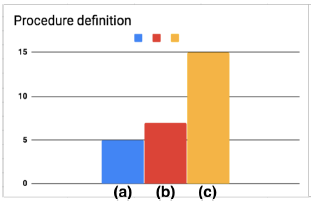
Figure 9 Result of the post-test: Procedures understanding. Labeling: a-incorrect, b-partially correct, c-totally correct
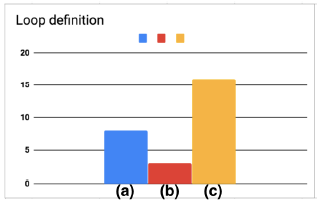
Figure 10 Result of the post-test: Loop understanding. Labeling: a-incorrect, b-partially correct, c-totally correct
The answers to Question 3 showed that most groups consider that the mission has been completed [Figure 11]. In our analysis, 78% of groups said they had completed the mission, 15% said they had partially developed, and only 7% said they had not completed it.
7. Conclusion
This paper presented a Collaborative Learning strategy aimed at Digital Games for learning Computational Thinking skills. As a differential, the approach seeks to incorporate the collaborative learning features proposed in the literature. In addition, the approach was developed specifically to fit the games’ dynamics in a motivating way so that students become protagonists of their own learning. An analysis of metacognitive and transactional acts and a survey were applied in different situations were used to evaluate the strategy.
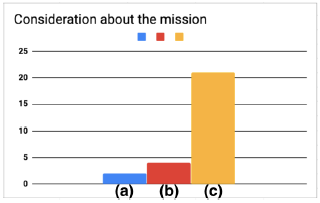
Figure 11 Result of the post-test: mission self-assessment. Labeling: a-not completed, b-partially developed, c-fully completed
The results were promising since there was evidence that the collaborative interactions helped learners to propose satisfactory solutions and learn in a funny way. As a future work, we intend to perform evaluations of the proposed framework applied to Game Production activities (using a Game Development Environment) in order to understand how the approach can help on these practices.













